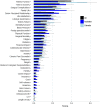Identifying Outcomes that Are Important to Living Kidney Donors: A Nominal Group Technique Study
- PMID: 29853616
- PMCID: PMC5989678
- DOI: 10.2215/CJN.13441217
Identifying Outcomes that Are Important to Living Kidney Donors: A Nominal Group Technique Study
Abstract
Background and objectives: Living kidney donor candidates accept a range of risks and benefits when they decide to proceed with nephrectomy. Informed consent around this decision assumes they receive reliable data about outcomes they regard as critical to their decision making. We identified the outcomes most important to living kidney donors and described the reasons for their choices.
Design, setting, participants, & measurements: Previous donors were purposively sampled from three transplant units in Australia (Sydney and Melbourne) and Canada (Vancouver). In focus groups using the nominal group technique, participants identified outcomes of donation, ranked them in order of importance, and discussed the reasons for their preferences. An importance score was calculated for each outcome. Qualitative data were analyzed thematically.
Results: Across 14 groups, 123 donors aged 27-78 years identified 35 outcomes. Across all participants, the ten highest ranked outcomes were kidney function (importance=0.40, scale 0-1), time to recovery (0.27), surgical complications (0.24), effect on family (0.22), donor-recipient relationship (0.21), life satisfaction (0.18), lifestyle restrictions (0.18), kidney failure (0.14), mortality (0.13), and acute pain/discomfort (0.12). Kidney function and kidney failure were more important to Canadian participants, compared with Australian donors. The themes identified included worthwhile sacrifice, insignificance of risks and harms, confidence and empowerment, unfulfilled expectations, and heightened susceptibility.
Conclusions: Living kidney donors prioritized a range of outcomes, with the most important being kidney health and the surgical, lifestyle, functional, and psychosocial effects of donation. Donors also valued improvements to their family life and donor-recipient relationship. There were clear regional differences in the rankings.
Keywords: Acute Pain; Australia; Canada; Decision Making; Focus Groups; Informed Consent; Kidney Donors; Life Style; Living Donors; Nephrectomy; Nominal Group Technique; Personal Satisfaction; Qualitative Research; Renal Insufficiency; Risk Assessment; outcomes.
Copyright © 2018 by the American Society of Nephrology.
Figures



Comment in
-
Living Donation: The Donors and Recipient Perspectives.Clin J Am Soc Nephrol. 2018 Jun 7;13(6):823-824. doi: 10.2215/CJN.05520518. Epub 2018 May 31. Clin J Am Soc Nephrol. 2018. PMID: 29853614 Free PMC article. No abstract available.
-
Donor Outcomes: Why We Need to Listen.Clin J Am Soc Nephrol. 2018 Jun 7;13(6):831-832. doi: 10.2215/CJN.05000418. Epub 2018 May 31. Clin J Am Soc Nephrol. 2018. PMID: 29853615 Free PMC article. No abstract available.
References
-
- Global Observatory on Donation and Transplantation: Organ donation and transplantation activities, 2014. Available at: http://www.transplant-observatory.org/data-reports-2014/. Accessed January 1, 2014
-
- Terasaki PI, Cecka JM, Gjertson DW, Takemoto S: High survival rates of kidney transplants from spousal and living unrelated donors. N Engl J Med 333: 333–336, 1995 - PubMed
-
- Reese PP, Boudville N, Garg AX: Living kidney donation: Outcomes, ethics, and uncertainty. Lancet 385: 2003–2013, 2015 - PubMed
Publication types
MeSH terms
Grants and funding
LinkOut - more resources
Full Text Sources
Other Literature Sources
Medical

